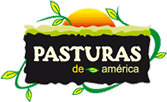Introduction
The registration of the Mulato hybrid brachiaria (Brachiaria ruziziensis x B. brizantha) by Grupo Papalotla in 2001 and the granting of Plant Variety Rights (PVR) in 2002 marked a significant breakthrough for tropical perennial grass cultivars. Mulato was the first hybrid brachiaria cultivar released from the hybridization program that begun in 1988 at CIAT (Centro Internacional de Agricultura Tropical).
Up until 2001, commercially used Brachiaria spp. cultivars were derived without genetic modification directly from natural collected germplasm from Africa or selected from germplasm collections in Australia and in tropical America. The development in Belgium of a tetraploidized sexual ruzigrass (B. ruziziensis) by Ndikumana in 1985 and further research by Valle et al. in 1994, led to Dra. Cacilida B. do Valle of Embrapa (Empresa Brasileira de Pesquisa Agropecuária) providing a tetraploid, sexual ruzigrass to CIAT in 1988.
The breeding program at CIAT, led by Dr John W. Miles, combined desirable attributes such as drought and spittlebug resistance. Three apomictic hybrids have been released. Mulato in 2002, Mulato II (B. ruziziensis x B. decumbens x B. brizantha) in 2004 and CIAT BR02/1752 (B. ruziziensis x B. decumbens x B. brizantha), in 2011.
In 2001, the Mexican seed company Group Papalotla was granted worldwide exclusive rights by CIAT to produce, research, and commercialize the Brachiaria hybrids developed in the 2001-2010 period. Mulato, the 1st hybrid released showed considerable agronomic potential but seed yields were low.
Tests conducted in Central America then demonstrated the superiority of Mulato II, a vigorous grass with deep (1.5 m), and branched roots, giving it excellent drought resistance in the Brazilian Cerrado and tropical Mexico. Mulato II seed yields in Thailand were 60 and 100% larger than the highest seed yields of Mulato. Grupo Papalotla withdrew Mulato from the market and concentrated on seed production of Mulato II.
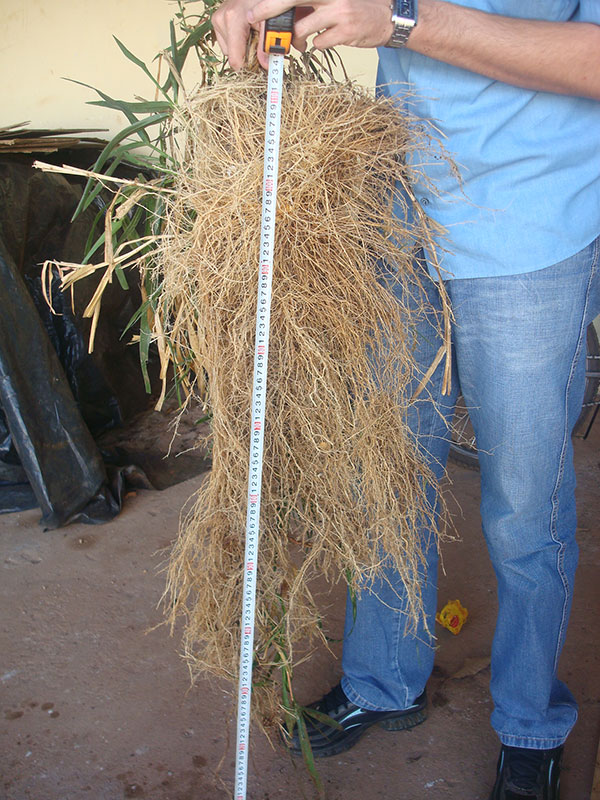
Cultivar Mulato II with deep roots
From 2003-2008, further detailed studies were conducted in Mexico and Thailand on 155 new brachiaria hybrid lines resulting in four lines, BRO2/1718, BRO2/1752, BRO2/1794 and BRO2/0465 being granted PVR.
BRO2/1752 produced similar dry matter yields to Mulato II, but in trials in Mexico demonstrated good water logging tolerance, in contrast to Mulato II which had very low water logging tolerance leading to extensive plant death. BRO2/1752 has since been released as cultivar Cayman.
This communication summarizes the considerable amount of research conducted on growth, quality, production, and seed yields of brachiaria hybrids in Asia, Central America and Africa from 2003 to 2013.
Regional evaluations and research
Asia
Field studies at Ubon Ratchathani University, Thailand (15°N), between 2003 and 2007, showed that Toledo palisade grass (Brachiaria brizantha), Mulato and Mulato II produced more total dry matter and leaf dry matter, particularly during the dry season than other brachiaria accessions. Mulato II also produced significantly more leaf than the other brachiaria grasses in the studies. It has been the production of green leaves by Mulato II that has made it extremely attractive forage for livestock.
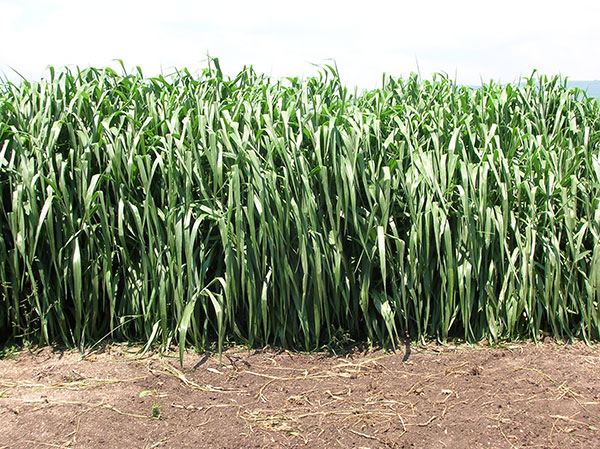
Mulato II: Suitable for grazing, forage conservation and cut and curry
From 2005 to 2008, 15 hybrid brachiaria lines were evaluated at Ubon Ratchathani University for forage yield, quality and seed production. Only two lines, BRO2/0465 in the wet season and BRO2/1752, produced more dry matter than Mulato II. BRO2/1794 produced significantly more seed than all the other hybrids in both trials. Mulato II, BRO2/1752, BRO2/0465 and BRO2/1718 produced similar seed yields, averaging 150 kg/ha.
From 2008 to 2011, a further 28 hybrid brachiaria BRO6 lines were evaluated alongside Mulato II, Marandu, Toledo and promising BRO2 lines, 1794, 0465, 1718 and 1752. None of the BRO6 lines produced significantly more dry matter than Mulato II. Mulato II produced significantly higher percentage of leaf DM than all the other lines in both the wet season and dry season.
Mulato II, BRO2/1752 (Cayman) and BRO2/1794 were evaluated further for dry matter production and seed production at Ubon Ratchathani University from 2009-2011. All three lines produced similar total DM yields, but Mulato II produced significantly less stem and significantly more leaf DM than Cayman and BRO2/1794. BRO2/1718 and BRO2/1794 produced similar seed yields averaging 260 kg/ha, which was 43% higher than Mulato II seed yield.
Field trials conducted by the Thailand Department of Livestock Development (DLD) from 2004 to 2006 in northern Thailand (18°N; 319 m.a.s.l.)), showed that Mulato and Mulato II produced significantly higher DM yields than ruzi grass, but ruzi grass produced 3-4 times the seed yields of Mulato and Mulato II. In the dry season, Mulato and Mulato II produced 60% more DM than ruzi grass. In seed production trials conducted by DLD from 2007 to 2008 in northern Thailand at the same location, Mulato II produced significantly more seed (500 kg/ha) than BR02/1752 (290 kg/ha), BRO2/1718 (250 kg/ha), BRO2/1794 (390 kg/ha), BRO2/0465 (145 kg/ha), Mulato (220 kg/ha), ten MX02 lines (180 kg/ha), eight BRO4 lines (157 kg/ha) and twenty BRO5 lines (40 kg/ha).
Further trials conducted in Thailand by DLD, showed that digestible dry matter of Mulato II and three hybrid brachiaria lines was excellent. Leaf digestible matter averaged 75% and stem digestible dry matter averaged 60%. This was similar to findings later reported at University of Florida, USA.
In Guangxi, China (25°N), Mulato II was found to be very susceptible to winter cold, with only 5% plant survival in May, following two days below 0°C in December and many weeks with temperatures close to zero. This was similar to results from Florida, USA, where Mulato II pastures can be considerably weakened by winter cold temperatures below 0°C and then recover slowly in the spring.
The Americas
Seed production trials were conducted at Warnes, Bolivia (19°S; 423 m.a.s.l.) from 2007 to 2010 on hybrid brachiaria lines BRO5, MXO2 and BRO4. Over four years, only one new line, MXO2/2552, produced more seed than Mulato II and this was due to the high seed yield in 2010. In 2009, seed yields were low overall, due to dry conditions during anthesis and seed set.
Further trials from 2008-2010 at the same location found that none of the BRO6 lines produced significantly more seed than Mulato II. The outstanding hybrid line in this trial was BRO2/0465 which produced significantly more seed than Mulato II, similar to the high yields shown by this line in Thailand.
In Brazil, a set of observations trials were conducted at Anhumas, San Paulo State (22° 17′ 43″ S, 51° 23′ 10″ W; 470 m.a.s.l.) in a tropical savanna climate from 2009-2011. In a field planted with Mulato II, unreplicated plots yielded 10 tonnes/ha DM after sowing and reached a maximum of 25 tonnes at 90 days of age. In these trials, more dry matter was produced during dry periods with good radiation than during periods of heavy rainfall and overcast days. Cutting regrowth every 30 days in the wet season produced crude protein levels ranging from 14 to 16%. In the same field, 26 Brahman steers were grazed during the dry season for 90 days at a stocking rate of six animals per hectare. Their liveweight gain was 777 grams/day without supplementation.
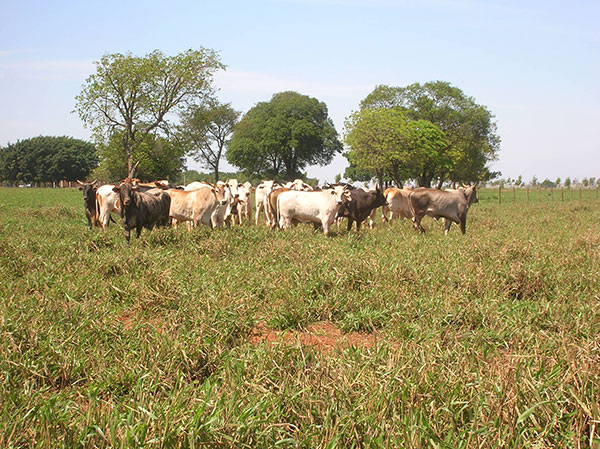
Mulato II under grazing in the Brazilian Cerrado during the dry season
In Mexico, evaluations on the hybrid brachiaria collections commenced in 2005 at Santa Elena, Oaxaca (16°N, 4-8 m.a.s.l., 800-1200 mm annual rainfall, 6-8 months dry season) on very sandy soils, with low organic matter, low N, low P and a pH of 5.6. To date, studies have been conducted on BRO2, BRO5, BRO6 and BRO9 lines.
Further trials with BRO2/1752 (Cayman) showed that it displayed superior waterlogging tolerance compared to Mulato II and 38 BRO6 lines. This was probably associated with the large number of adventitious roots in BRO2/1752 (1065/plant) compared to Mulato II (4/plant) following 55 days of flooding (Esteban Pizarro unpublished data).
BRO2/1752 also has very good drought tolerance and very rapid regrowth at the onset of the wet season. BRO2/1752 has been released as cultivar Cayman.
Rooting at the nodes allowed for rapid colonization of bare areas in pastures and represents a considerable advantage in terms of persistence under grazing and for erosion control.
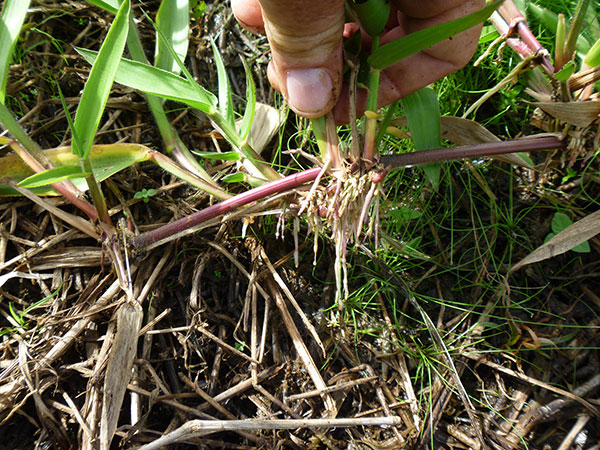
Cayman: Waterlogging tolerance due to the development of adventitious roots
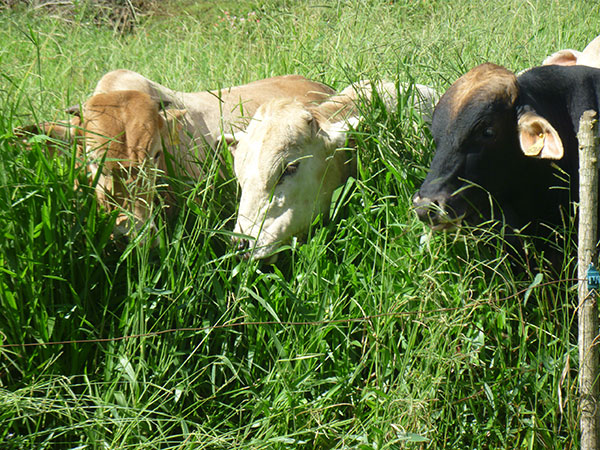
Cayman under grazing in the humid tropic of Costa Rica
Within the BRO9 collection there is some outstanding material which will be evaluated for another 3 years in Mexico and Thailand.
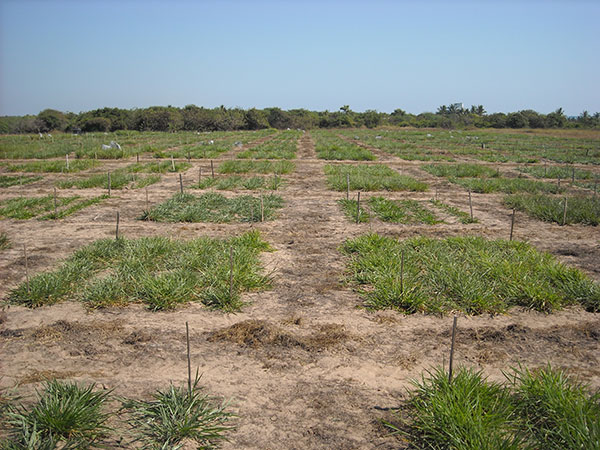
The new Brachiaria hybrids collection under evaluation
Small plot dry matter yields of two released cultivars (Mulato II, Cayman) at 120 days of regrowth after cutting were 30 and 21 tonnes respectively.
Studies at the University of Florida, Beef Research Unit (29°N; 45 m.a.s.l.) from 2010-2011, have been conducted on forage production, nutritive value and persistence of Mulato II and Cayman under grazing conditions (Lynn Sollenberger, Andre Soares, João Vendramini pers. comm.). Results from these experiments showed high nutritive value (crude protein and in vitro organic matter digestibility), in both brachiaria hybrids. Under grazing every two weeks, both hybrids had significantly higher percentages of leaf (70-80%), crude protein (19-21% in leaves, 10-12% in stems) and IVDOM (73-75% leaf, 59-61% stem) than grazing every 4 and 6 weeks, similar to the high quality achieved under cutting in Thailand. There were no significant differences in dry matter production between grazing intervals of 2, 4 and 6 weeks.
Africa
Improved hybrid brachiaria grasses were evaluated in Rwanda (2°S) at a lower rainfall site (1400 mm/year) and a higher rainfall site (1800 mm/year) that had high Al soil levels (47 meg/100g of soil), against an indigenous signal grass (B. decumbens) and a naturalized buffel grass (Cenchrus ciliaris).
Farmers were asked to rank the grasses and they selected Mulato II as the preferred cultivar at both sites, because of its production of green forage all year round without any input of fertilizer (Mutimura and Everson, pers. comm.)
Commercial pasture development
Mulato II pastures have been successfully established by farmers in Asia, the Pacific Africa, and Central and South America.
In Vietnam, Mulato II is used as a cut-and-carry forage and is promoted as a suitable grass for dairy farmers because of its high protein levels, high palatability and high digestibility compared to other tropical grasses used there (Raf Somers pers comm.). In Thailand, Laos and Malaysia, expansion of Mulato II has been slow, due to the strong competition from far cheaper ruzi grass seed produced in Thailand.
In the Pacific region, over 10,000 hectares of Mulato II pastures have been established in Vanuatu since 2007 where it is primarily used for beef cattle grazing. Mulato II pastures are expanding in New Caledonia and Papua New Guinea.
In Africa, Mulato II pastures have been established on nearly 1000 smallholder farms in Kenya, Tanzania and Ethiopia and on larger farms in Congo and Uganda.
In the Americas, nearly 200,000 ha of Mulato II pastures have been established since 2005 for both dairy and beef cattle grazing.
Commercial seed production
Mulato II and Cayman seeds in Thailand and Laos are harvested by hand. In Thailand, the seed is ground-swept and in Laos the seed is harvested by knocking the seed from seedheads. The seed is hand cleaned by the farmers and then acid- scarified in Thailand to reach 98% purity, 90% seed viability and 80% seed germination.
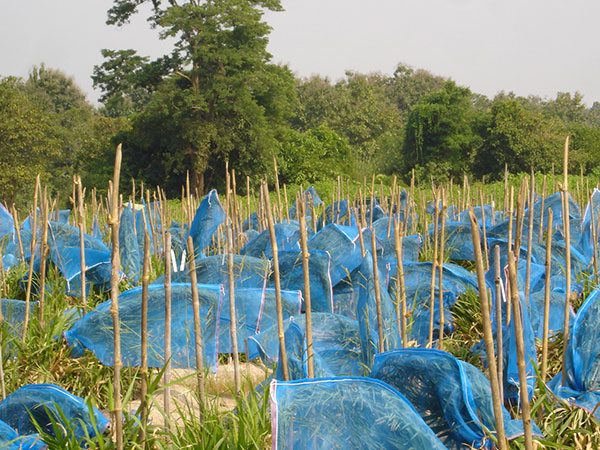
Seed production field in Thailand
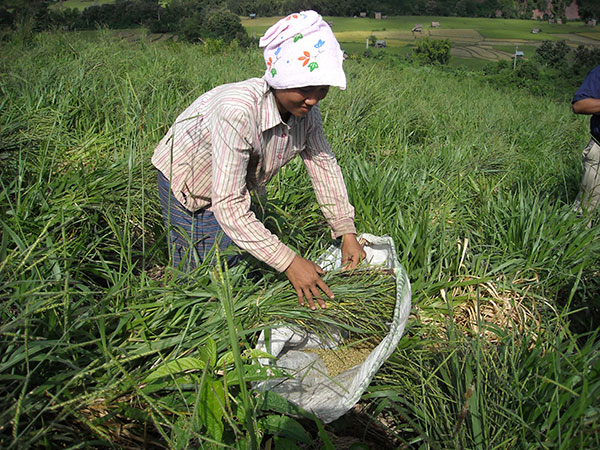
Seed hand harvesting in Laos

Sweeping Mulato II seed in Thailand
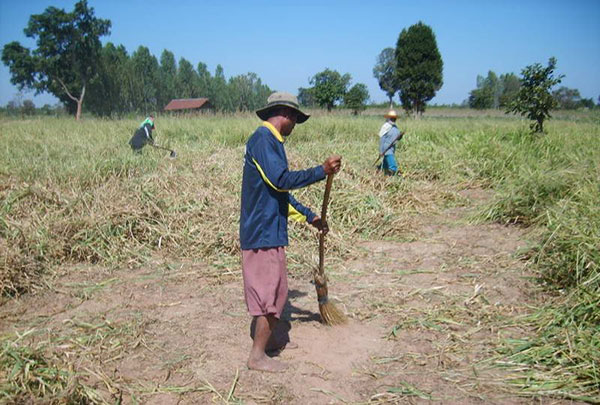
Sweeping Mulato II field in Thailand
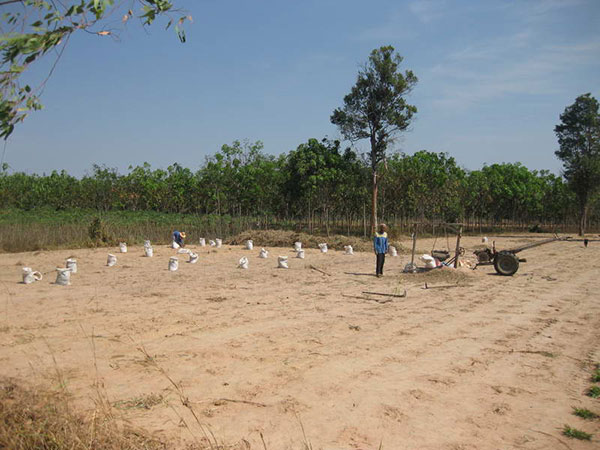
Mulato II seed field in Thailand
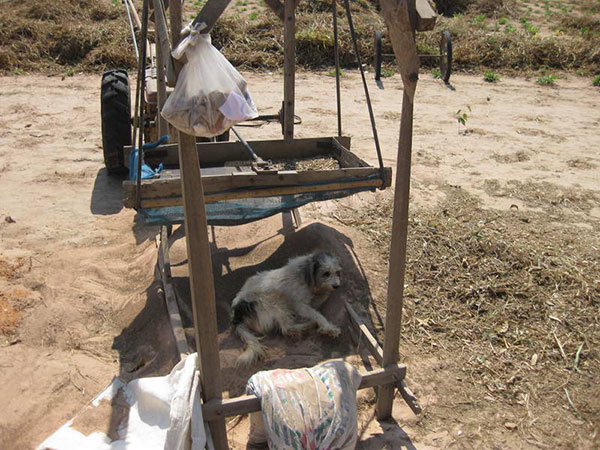
Seed cleaning equipment in Thailand
In Central and South America, seed is only produced in Mexico (Mulato II and Cayman) and Brazil (Mulato II). All the seeds are ground-swept using machinery. The seeds are cleaned and acid-scarified at a central locality in each country.
Conclusion
Mulato and Mulato II were the first hybrid brachiaria cultivars released from the CIAT breeding program in 2001 and 2004, respectively. Since 2003, a considerable amount of research has been conducted on 155 hybrid brachiaria lines in Central and South America and in Asia, and only one new cultivar released, Cayman in 2011. The outstanding waterlogging tolerance of Cayman has added a new dimension to the hybrid brachiaria collection.
Four other lines (BRO2/1794, BRO2/1718 and BRO2/0465) were granted PVR in 2011. In some trials, lines were found that had better dry matter production than Mulato II, but it has been extremely difficult to find among the 155 lines so far evaluated, materials that out yield Mulato II in terms of seed production while maintaining high forage quality and dry matter production.
Research is continuing to evaluate the new BRO9 collection. The aim is to find materials that display some of the following traits: combine high seed yields with high forage quality; persistence under heavy grazing; high drought tolerance; erect growth habit and high dry matter yields for cut-and-carry forage systems, or that display good shade tolerance.
Acknowledgements
We thank SEFO Bolivia (Karla Claros, Emidgio Ramírez, Gastón Sauma, Julio Horacio, Antezana Rojas, Técnico Cirilo Zamora); Tropical Seeds, Brazil (Leobardo Calderón Cardoso, Renato Herrero Navarro, Daniel Neco, Davi Lucas Pereira); CIPAT, Mexico (Rodolfo Ruíz Ramón, Francisco Avila, Alberto López, Usiel Reyes Campechano); DLD, Thailand (Chaisang Phaikaew, Ganda Nakamanee, Weerapon Poonpipat, Pimpaporn Polsen) and the University of Florida, USA (João Vendramini, Lynn Sollenberger, Andre Soares, Cliff Lamb, Adesogan Adegbola), for all their research collaboration on hybrid brachiarias.
1. Grupo Papalotla, Semillas Papalota SA de CV., Orizaba, N°195, Colonia Roma, Delegación Cuauhtemoc, 06700, Mexico D.F.
2. Faculty of Agriculture, Ubon Ratchathani University, Ubon Ratchathani 34190, Thailand.

